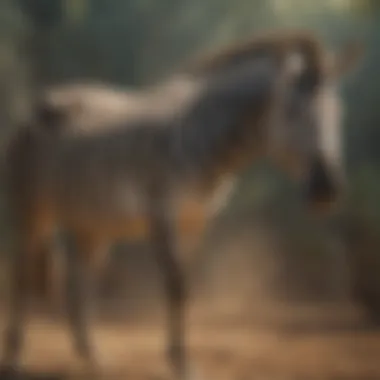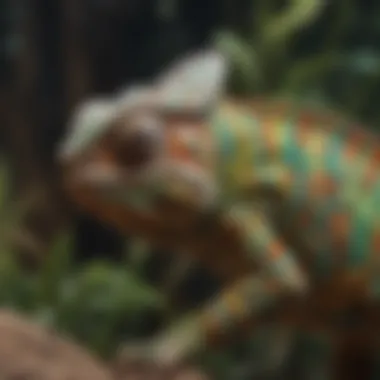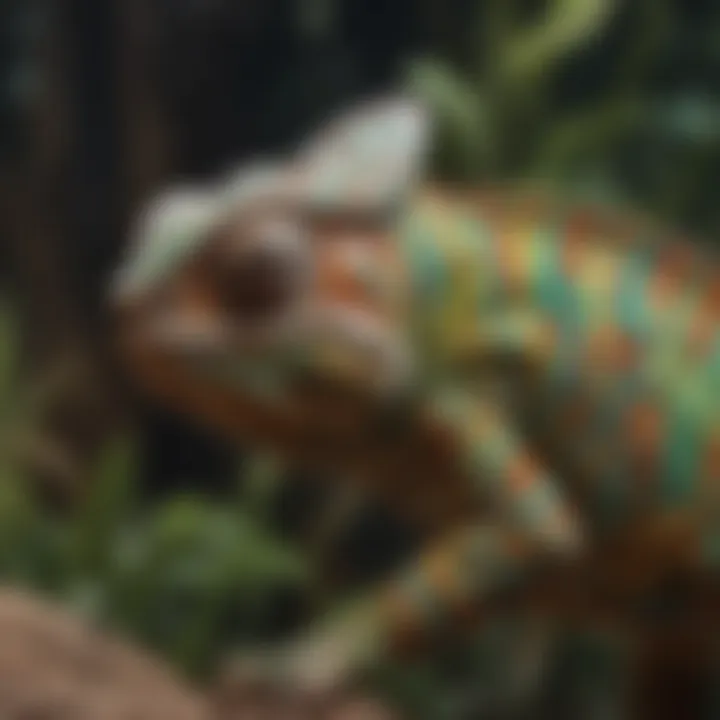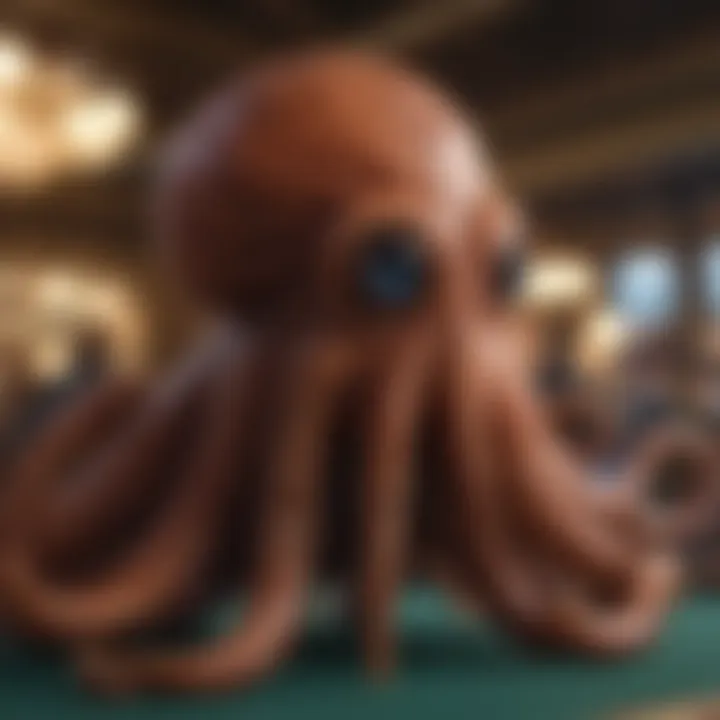Illusions in the Animal Kingdom: Mirage Creatures Uncovered


Intro
In the vast and varied tapestry of nature, some animals have perfected the art of deception to remarkable degrees. These creatures, often dubbed as mirage animals, employ intricate adaptations to camouflage themselves or manipulate the perceptions of other beings in their ecosystem. The strategies they use to evade predators or ensnare their prey reveal not just the intricacies of their biology but also offer fascinating insights into evolutionary processes.
Understanding these adaptations is essential for grasping the delicate balance within ecosystems. By investigating the lanes where perception meets reality, it may become clear how these illusions play a pivotal role in survival and can have implications for conservation efforts.
The following sections aim to explore these complex adaptations through various examples, highlighting how mirage animals thrive in their habitats. Each instance provides a compelling narrative that unfolds the challenges of survival. The interplay of visual trickery and natural instinct becomes a rich ground for discussion, offering a peek into the minds of these phenomenal beings where the line between reality and illusion blurs.
Understanding Mirage Animals
The exploration of mirage animals encourages a deep dive into the perplexing realities of the natural world. These creatures, which often rely on the art of deception for survival, serve as poignant reminders of how perception can be manipulated in the wild. Understanding mirage animals not only enriches our comprehension of ecological dynamics but also adds layers of complexity to the study of evolutionary biology.
Definition and Importance
At its core, a mirage animal is one that employs visual deception techniques to survive against predators or to catch prey. This includes mimicry—a phenomenon where one species resembles another to thrive in their specific habitats. Think of the leaf-tailed gecko, for instance. Its ability to blend in with leaves underscores how fundamental visual tricks can be in the world of animals.
These adaptations are not merely fascinating; they're critical in maintaining the delicate balance within ecosystems. The strategies these animals use not only affect their survival rates, but also influence the behavior and adaptations of other species within the same environment. Thus, studying these creatures can reveal much about the interconnected webs of life, showcasing nature's innovative mechanisms for survival.
Evolutionary Background
Digging deeper into the genesis of these illusions necessitates an understanding of evolution's role in shaping such remarkable traits. Mirage animals have developed their unique adaptations through millions of years of natural selection. Those that could blend in or imitate other species had a distinct advantage, as predators found it challenging to identify them. For example, consider the stick insect, which has evolved to look like twigs or branches. This simple form of survival illustrates a clever twist on the classic adage about not seeing the forest for the trees.
The evolutionary pressure of predation has driven a multitude of species to adopt mimicry and camouflage, underlining an intriguing maxim of the natural world: to survive, sometimes you must become unseen or unrecognized. This evolutionary dance, driving both predator and prey strategies, forms an intricate tapestry that enriches the ecological landscape.
This evolutionary narrative doesn't just explain the present. It also prompts reflections on how climate change and human intervention might affect these interactions moving forward. As environments shift, the learned behaviors of both predators and prey may be put to the test, indicating a crucial area of research for future conservation efforts.
Types of Illusions in Nature
The exploration of illusions within the animal kingdom is not just an academic curiosity; it offers significant insights into the survival mechanisms of various creatures. These illusions—ranging from mimicry to camouflage—play pivotal roles in ecological dynamics. By understanding the specific elements at play in nature's great theater, we can glean important considerations about predator-prey relationships and their evolutionary processes.
Mimicry as Deception
Mimicry stands out as one of nature's most brilliant tricks. This is where one organism, known as the mimic, evolves to resemble another, often for its own survival. The mimic gains an advantage by confusing predators or prey, thereby skewing their perception. This deception can manifest in various ways, such as visual mimicry, auditory mimicry, or even chemical mimicry. A striking example includes the viceroy butterfly. While it looks remarkably similar to the toxic monarch butterfly, the viceroy is safe to consume. Predators learn quickly not to eat the butterflies that taste bad, inadvertently sparing the viceroy due to its disguise.
"In nature, mimicry is not mere imitation; it is survival itself."
Camouflage Techniques
Camouflage is another essential strategy in the animal kingdom that allows creatures to blend into their environments. This technique goes beyond simple hiding; it involves complex adaptations that can include color change, pattern distortion, and even texture alteration. Take the chameleon, for instance, which can change its skin color to match its surroundings, becoming nearly invisible to both predators and prey. Likewise, the Arctic fox showcases a coat that shifts from brown in summer to white in winter, blending seamlessly with its snowy habitat. These adaptations underscore a crucial aspect of evolutionary biology—the fight between visibility and invisibility, where those who master this subtle balance often tend to thrive.
Behavioral Adaptations
Behavioral adaptations also contribute significantly to the illusions we see in the animal kingdom. Some animals display unique behaviors to enhance their survival. The octopus is a prime example, demonstrating incredible skills like shape-shifting and motion control. It can alter not only its color but also its texture, mimicking surroundings like rocks or coral to escape detection. Such behavioral flexibility plays a fundamental role in the adaptation narrative, showcasing how animals manipulate their actions to defy the predatory gaze. The complexity of these strategies leads to a fascinating realization: survival is often a question of perception and deception, where behavior becomes as crucial as physical traits.
Pivotal Examples of Mirage Animals


By exploring pivotal examples of mirage animals, we gain valuable insight into the complex world of adaptation and survival in nature. These creatures offer tangible demonstrations of how specific evolutionary strategies not only help them escape predators but also shape their interactions within ecosystems. Understanding these examples enhances our appreciation of biodiversity and the ingenious ways life can adapt to various pressures.
The Leaf-Tailed Gecko
The Leaf-Tailed Gecko, native to Madagascar, is a stunning manifestation of camouflage. When resting on a leaf, its body shape and color blend seamlessly into its environment. This species has evolved an extraordinary ability to mimic not just the color of leaves but also their texture. This adaptation serves as a potent defense mechanism against both predators and potential threats.
Intriguingly, this gecko's ability to remain undetected extends beyond mere appearance. Behaviorally, these reptiles remain incredibly still, often waiting long periods for the right moment to ambush their prey or evade danger. Furthermore, their flattened bodies give them impressive versatility in navigating their habitat, enabling them to wiggle through brush in a way that further obscures their presence.
The Stick Insect
Stick Insects are the masters of disguise. As their name suggests, these insects have evolved body shapes and colors that resemble twigs or branches. This mimicry not only renders them nearly invisible to would-be predators but also allows them to remain close to their food sources—leaves—without drawing attention.
Their camouflage is complemented by subtle movements and an innate ability to mimic the behavior of sticks, swaying gently in the wind. Stick Insects display a fascinating aspect of survival; they exhibit both crypsis and mimicry. This means they not only hide but actively blend into their surroundings through movement—such as swaying or holding still—turning them into a masterful illusion.
The Ghost Pipefish
The Ghost Pipefish, primarily found in the waters of the Indo-Pacific, is perhaps one of the ocean's most captivating examples of mimicry. Resembling floating seaweed or coral, these fish showcase an outstanding capacity for illusion within their aquatic habitats. Their elongated bodies and fins have evolved to mimic the look of marine plants, making them nearly indistinguishable in their surroundings.
This camouflage gives the Ghost Pipefish an advantage in avoiding predators. Moreover, it aids in hunting, as smaller prey often swim too close, oblivious to the lurking threat. These adaptations highlight the delicate dance between predator and prey in the underwater ecosystem, showcasing how critical such illusions are for survival for both sides.
The Cuttlefish
Cuttlefish, akin to the chameleons of the sea, are renowned for their remarkable ability to change color and texture at will. With specialized skin cells known as chromatophores, they can achieve a range of patterns that make them almost invisible in their surroundings. This ability to adapt their visual appearance serves multiple purposes, from escaping threats to stunning prey.
Additionally, cuttlefish communicate with one another through these color changes, asserting dominance or attracting mates without uttering a word. Their behavior further complements their incredible camouflage, often employing shifty movements that make it difficult for predators to track them. The cuttlefish exemplifies how complex evolutionary strategies encompass both visual deception and behavioral finesse, providing a robust example of the interplay of illusion in the animal kingdom.
"In nature, being invisible can mean the difference between life and death for these incredible creatures."
In summary, these pivotal examples of mirage animals showcase the awe-inspiring ways that evolution crafts unique adaptations. By studying these distinct creatures, we come to understand the intricate relationship between appearance, behavior, and survival. Such insights not only inform our knowledge of biodiversity but also enhance our awareness of how fragile and interlinked ecosystems are in our ever-changing world.
Ecological Significance of Illusions
The realm of mirage animals offers rich insights into the ecological tapestry of our planet. These creatures are not merely curiosities but pivotal players in their ecosystems. The illusions they create—through mimicry, camouflage, and other deceptive behaviors—serve essential roles that affect survival rates, prey-predator interactions, and biodiversity. Understanding these dynamics helps us appreciate how intricate the web of life truly is.
Role in Ecosystems
In ecosystems around the globe, mirage animals act like the craftsmen of their environments. Consider the chameleon, famed for its ability to change color. This isn't just a party trick; it’s a survival technique that aids in blending into backgrounds and avoiding predators. When these animals thrive, the entire ecosystem often flourishes. Their adaptations can influence the distribution of other species, affecting factors such as population density and community structure. For instance, in a tropical rainforest, the presence of well-camouflaged insects can help maintain plant diversity. Plants rely on specific pollinators, many of which are also prey for mirage animals. Thus, illusions contribute directly to the stability of ecosystems by fostering relationships of exclusion and coexistence.
Impact on Predator-Prey Dynamics
Mirage animals dramatically shape the interactions between predators and prey. When a creature can effectively blend into its surroundings, it alters the balance of power. Think of a crafty octopus that uses color-changing skin to hide among coral reefs; its survival hinges not just on escaping detection, but also on how its mirrored colors impact the hunting tactics of predators.
The benefit is reciprocal. Predators, too, evolve strategies in response to the adaptive abilities of their prey. Take the case with the mantis shrimp, known for its exceptional vision. As it hunts in vibrant coral environments, its prey may develop elaborate patterns, enhancing their chances of survival. This gives rise to an evolutionary arms race, compelling both sides to continuously adapt and refine their strategies—an intricate dance that sustains ecological balance.
Consequences for Biodiversity


The presence of mirage animals influences biodiversity at multiple levels. They contribute to the richness of life by promoting variety within ecosystems. A striking example is the diverse forms of stick insects; they provide a buffet of options for food chains while simultaneously enriching their habitats with various phenotypes.
Biodiversity isn't just about species counting; it matters for ecosystem resilience. Greater diversity fosters stability, enabling ecosystems to withstand shocks like disease or climate variations. Mirage animals—often hidden from casual observation—are critical in maintaining this diversity. Their unique adaptations could even hint at how ecosystems might respond to future challenges, including pressuring species to adapt further or face extinction.
"In the balanced ecosystem, the mirage isn't merely illusion, but a fundamental strategy for survival."
Methodologies for Studying Mirage Animals
Studying mirage animals presents unique challenges and opportunities. These creatures, which superbly mimic or camouflage themselves to survive, necessitate particular methods to fully grasp their adaptations. Understanding these methodologies is crucial, as they illuminate how researchers can gain insights into the survival strategies of these fascinating beings. Selecting the right approach can reveal the complex interaction between appearance and the environment, enriching our comprehension of animal behavior and ecology.
Field Studies
Field studies serve as a primary means of observing mirage animals in their natural habitats. Such research often involves long hours in diverse environments, where patience is key. Observers may utilize techniques like tracking, direct observation, and behavioral analysis. These methods allow scientists to record how these animals interact with their surroundings and the ways they utilize their deceptive adaptations to evade predators.
"Field studies ensure real-world context, capturing the essence of survival as these animals navigate their environments."
In-depth fieldwork often compiles valuable data that can lead to groundbreaking conclusions about the effectiveness of various camouflage and mimicking techniques. For instance:
- Data Collection: Detailed notes on animal behaviors during different times of the day can provide insights into their adaptive strategies.
- Habitual Observation: Observing how a species interacts with its ecosystem offers a clear window into the functionality of its illusions.
- Alteration of Conditions: Altering environmental variables can show how adaptable these creatures really are.
Though rewarding, field studies often come with obstacles. If one is not familiar with the environment, important behavior patterns may go unnoticed. There’s also the risk of disturbing the ecosystems under observation, which is why ethical considerations are paramount.
Technological Approaches
With advancements in technology, studying mirage animals has evolved considerably. High-tech tools can aid in both observation and data collection. Here are a few notable approaches:
- Drones: Drones give researchers a bird's-eye view of landscapes, helping to spot elusive creatures without disturbing their habitat.
- Camera Traps: These devices capture images of wildlife, allowing scientists to study behavioral patterns without human interference. Setting them strategically can lead to discovering how well these animals employ their deceptive tactics.
- Digital Analysis: Innovative software can analyze footage and identify patterns that may not be visible to the human eye, revealing subtle behavioral cues that indicate the efficacy of camouflage.
Technological methods open doors to new forms of exploration and understanding. They allow for the collection of vast amounts of data while minimizing human presence in the field. However, these techniques often require a steep learning curve, and embracing new technology can be daunting for some researchers.
In summary, whether through traditional field studies or modern technological tools, studying mirage animals provides a holistic view of their unique adaptations. Each method offers its own set of insights and challenges, highlighting the need for a multifaceted approach to unlocking the secrets of these incredible creatures.
Challenges and Threats to Mirage Animals
The existence of mirage animals, with their fascinating adaptations, is under constant threat from various forces in nature. It is essential to discuss these challenges to understand not only the survival of these remarkable creatures but also the intricate balance of ecosystems they inhabit. Addressing habitat loss, climate change, and ongoing conservation efforts helps outline the precarious situation these animals face.
Habitat Loss
One of the prime culprits in the decline of mirage animals is habitat loss, often driven by human activities. Urban development, logging, and agriculture carve into the natural landscapes where these animals thrive. Each of these activities disrupts their environment, making it harder for mirage animals to use their adaptive strategies effectively. For example, the forest home of the Leaf-Tailed Gecko becomes less suitable when trees are cut down or when invasive species take over, affecting not just their survival but the entire food web.
Furthermore, as their habitats shrink, these animals face increased competition for resources. Their unique adaptations may provide some defense, but in dwindling spaces, even the most skillful illusions may fall short against the pressing realities of declining biodiversity. The essence of their camouflage or mimicry might lose significance if the environments in which these traits evolved cease to exist.
Climate Change
Beyond habitat destruction, climate change poses a significant threat to mirage animals. Rising temperatures and shifting weather patterns can alter ecosystems rapidly and dramatically. For instance, color and texture are essential for many of these species in their mimicry or camouflage techniques. If the climate changes too quickly, the natural landscapes that these animals have tailored themselves to might shift out from under them. The Ghost Pipefish, which thrives in specific marine conditions, might find itself at risk if ocean temperatures rise, as they depend heavily on the health of coral reefs, which are sensitive to temperature variances.


Moreover, climate change can provoke extreme weather events that can decimate whole populations. A sudden storm or drought can wipe out entire habitats as if they were mere mirages themselves. The uncertainty introduced by climate variability adds another layer of difficulty for these animals struggling to adapt.
Conservation Efforts
Given the challenges facing mirage animals, conservation efforts emerge as a crucial component in mitigating the threats they encounter. Protecting their habitats through the establishment of reserves and parks is paramount. Such initiatives not only secure the environments required for their survival but also foster education on their ecological significance. The more awareness about these animals, the better the chance for effective conservation measures.
Collaborative efforts between governments, organizations, and local communities can have profound impacts. Actions can range from habitat restoration to engaging in laws that protect these species from hunting and trade. Besides, advancements in technology offer new tools for tracking populations and assessing their changing environments, allowing scientists to gather data that may aid in their protection.
"To ignore the plight of mirage animals is to disregard the complexities of nature itself."
By investing efforts into these challenges, we not only protect the animals but also uphold the ecosystems that support our planet’s biodiversity.
Philosophical Implications of Animal Illusions
The study of mirage animals opens a nuanced conversation about the essence of reality and our understanding of it. The relationship between perception and reality is not just about how animals survive in their habitats, but extends into how we as observers interpret the natural world. When animals exhibit these elaborate strategies, it begs the question of how much of what we see is merely a reflection of our biases or limitations in understanding. This section aims to elucidate the intricate threads that connect the philosophical inquiry of illusions in nature to broader concepts of existence, cognition, and understanding.
Perception vs. Reality
In the realm of biology, illusions, such as those crafted by mirage animals, illustrate a compelling contrast between perception and reality. Take for instance the impressive camouflage of the peppered moth. On the quiet bark of a tree, it seems like just another patch of lichen. However, it’s crucial to recognize that our eyes, attuned to daylight and movement, may not grasp the subtleties that its predators rely on for detection. An observer can easily overlook how one species’ perception can cleverly differ from that of another.
Philosophically, this raises issues about the subjective nature of knowledge and truth. What is true for the predator, based on its own sensory perceptions, may not hold for the prey, which lives entirely in a different spatial and perceptual world. Are these truths absolute? Or are they just constructs of individual experiences? This exploration invites us to question not only how we see the creatures around us but also how we interpret the world at large.
%%%
"Reality is merely an illusion, albeit a very persistent one." - Albert Einstein
%%%
Insights into Human Behavior
Interestingly, delving into these animal illusions also provides a mirror to human behavior. Just as animals camouflage or mimic for survival, humans often employ similar strategies in varying social contexts. The concept of social camouflage, where individuals hide their true intentions behind a facade, is not all too far removed from the adaptations of a cuttlefish shifting colors in its watery realm.
When evaluating how society interacts with the apparent illusions in nature, one can see semblances in marketing strategies, social media portrayals, and even in poker—the art of bluffing. The art of deception, while often seen in a negative light, can pose as a necessary skill in the game of life, highlighting how context influences perception.
In summary, reflecting on these philosophical implications compels us to consider deeper questions about life, perception, and the often complex interplay of truth in our interactions, whether with nature or one another. The illusions animals create teach us that what we deem as reality might just be a nuanced perspective, colored by our individual lenses. Thus, reexamining our understanding could lead to richer interactions with both the animal kingdom and each other.
End: The Intricacies of Illusion in the Natural World
The study of mirage animals offers a kaleidoscopic view into the wonders of evolutionary adaptations. These creatures don’t just exist; they thrive amidst deception and disguise, skillfully using illusions to navigate the intricate dance of life. What emerges from this exploration is not only a testament to survival but also the revelation of deeper ecological and philosophical insights that beckon further examination.
Overall Reflection
When we reflect on the diverse range of mirage animals, it becomes clear that these adaptations are pivotal not solely for individual species but also for the broader ecosystems in which they reside. For instance, the striking camouflage of the cuttlefish or the exquisite mimicry displayed by the stick insect have roles that extend beyond mere survival—these techniques contribute to the delicate balance of predator-prey dynamics.
As we observe these animals, one can’t help but wonder about the implications for our understanding of nature itself. These illusions challenge our perceptions, prompting a re-evaluation of what we deem as ‘real’ in the animal kingdom. They whisper lessons of adaptability, the constant tug-of-war between visibility and invisibility, existence and obscurity. In a world increasingly fragmented by habitat loss and environmental changes, these insights become vital.
"The ways in which animals deceive are a mirror reflecting the complexities of life."
The Future of Research
Looking ahead, the future of research into mirage animals holds tremendous promise. Advancements in technology, such as high-speed cameras and digital imaging, will allow scientists to capture and analyze these fleeting moments, revealing the subtleties of animal behavior previously lost to the naked eye. This brings us to several considerations:
- Emerging Techniques: Innovative methods can enhance our understanding of animal illusions by showcasing how these adaptations cope with rapid environmental changes.
- Cross-Disciplinary Insights: Integrating studies from ecology, psychology, and even philosophy can enrich our comprehension of how life on this planet functions under the veil of illusion.
- Conservation Applications: Knowledge gained from studying mirage animals can inform conservation strategies, helping to prioritize which habitats hold the most significant potential for the survival of these elusive creatures.















